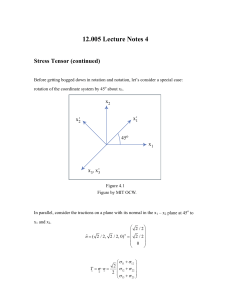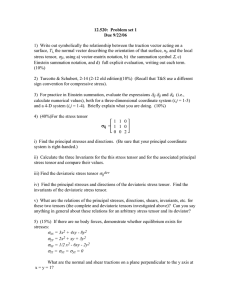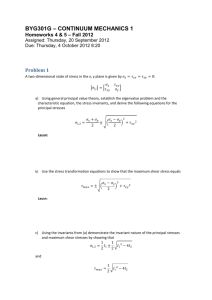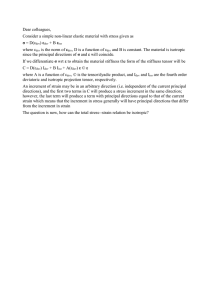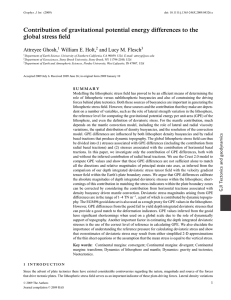Lecture 3: Different Representations of Stress
advertisement
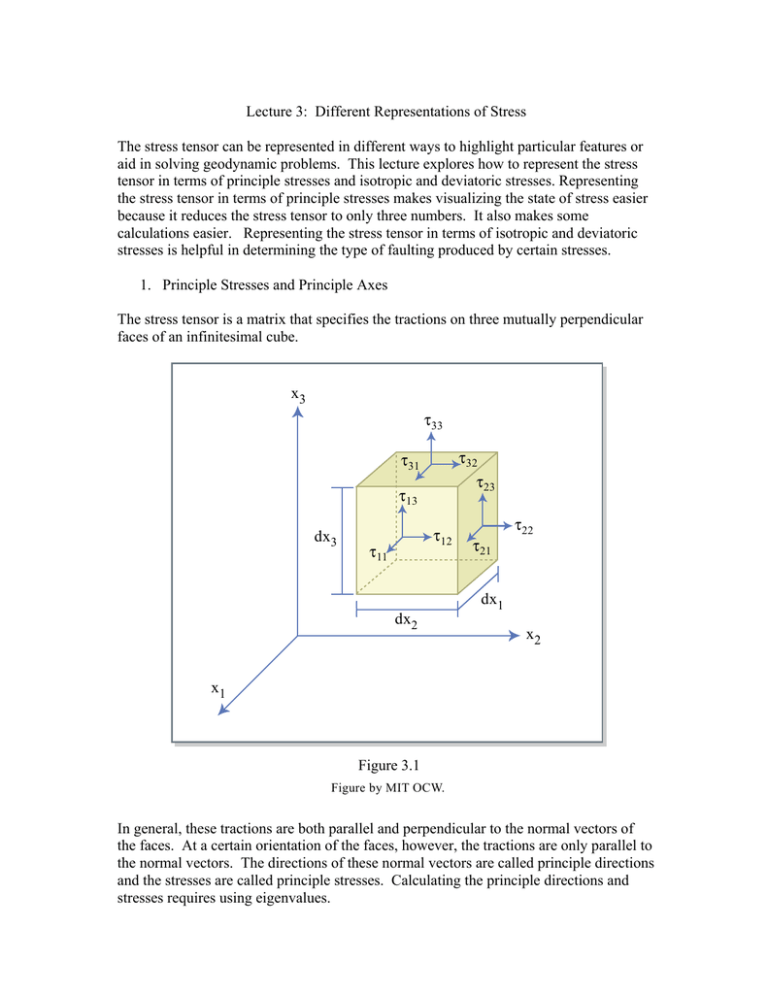
Lecture 3: Different Representations of Stress The stress tensor can be represented in different ways to highlight particular features or aid in solving geodynamic problems. This lecture explores how to represent the stress tensor in terms of principle stresses and isotropic and deviatoric stresses. Representing the stress tensor in terms of principle stresses makes visualizing the state of stress easier because it reduces the stress tensor to only three numbers. It also makes some calculations easier. Representing the stress tensor in terms of isotropic and deviatoric stresses is helpful in determining the type of faulting produced by certain stresses. 1. Principle Stresses and Principle Axes The stress tensor is a matrix that specifies the tractions on three mutually perpendicular faces of an infinitesimal cube. x3 τ33 τ32 τ31 τ23 τ13 dx3 τ12 τ11 dx2 τ21 τ22 dx1 x2 x1 Figure 3.1 Figure by MIT OCW. In general, these tractions are both parallel and perpendicular to the normal vectors of the faces. At a certain orientation of the faces, however, the tractions are only parallel to the normal vectors. The directions of these normal vectors are called principle directions and the stresses are called principle stresses. Calculating the principle directions and stresses requires using eigenvalues. a. Begin with Cauchy’s formula: Ti = τ ji n j Require the traction Ti to be parallel to the normal vector by writing Ti = λni in which λ represents one of the three principle stresses. b. Combine the above equations: τ ji n j = λni (τ ij − λδ ij ) n j = 0 τ 12 τ 13 ⎤ ⎡ n1 ⎤ ⎡τ 11 − λ ⎢ τ τ 22 − λ τ 23 ⎥⎥ ⎢⎢n2 ⎥⎥ = 0 ⎢ 21 ⎢⎣ τ 31 τ 32 τ 33 − λ ⎥⎦ ⎢⎣ n3 ⎥⎦ In the middle equation, δ ij is the Kronecker delta. It equals 0 if i≠j and equals 1 if i=j. c. Solve: The matrix equation has a solution if τ 11 − λ τ 21 τ 31 τ 12 τ 22 − λ τ 32 τ 13 τ 23 =0 τ 33 − λ where the double bars indicate the determinant. This results in a third-degree equation in λ − λ3 + I 1 λ 2 + I 2 λ + I 3 = 0 where I 1 = τ 11 + τ 22 + τ 33 − I2 = τ 11 τ 12 τ 11 τ 13 τ 22 τ 23 + + τ 21 τ 22 τ 31 τ 33 τ 32 τ 33 τ 11 τ 12 τ 13 I 3 = τ 21 τ 22 τ 23 τ 31 τ 32 τ 33 2. Isotropic and Deviatoric Stress The stress tensor can be divided into two parts: isotropic stress and deviatoric stress. 0 The isotropic stress τ ij is defined as 1 3 τ ij 0 = τ kk δ ij It represents the mean normal stress or pressure. Subtracting the mean normal stress d from the stress tensor produces the deviatoric stress τ ij τ ij d = τ ij − τ ij 0 The deviatoric stress represents the part of the stress that differs from a hydrostatic state.
